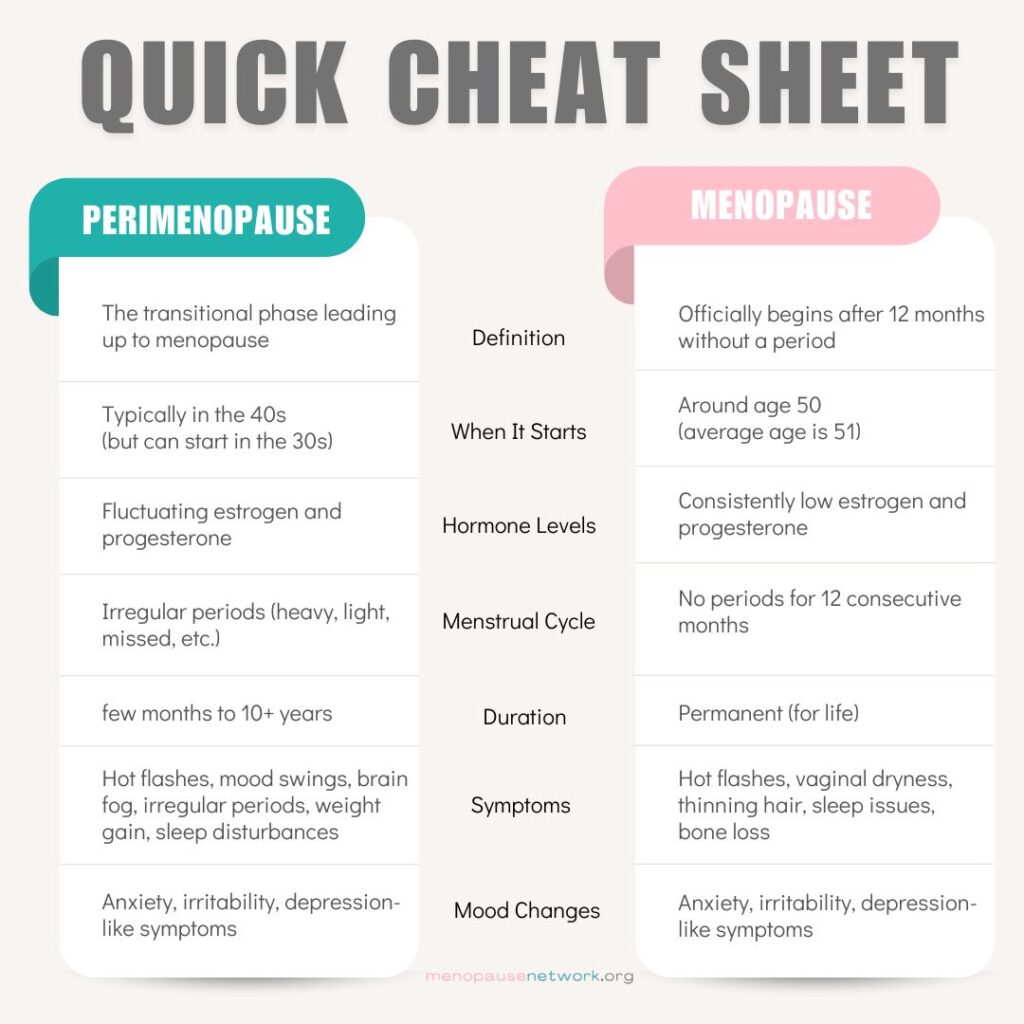Menopause vs. Perimenopause: What’s the Difference (and Why It Matters to Your Health)

Hot flashes out of nowhere? Mood swings that rival your teenage years? Wondering if you’re officially in menopause—or still stuck in the confusing in-between? You’re not alone. The transition from your reproductive years to menopause can feel like a mystery, and the terms perimenopause and menopause often get tossed around like they mean the same thing. Spoiler alert: they don’t.
Let’s clear up the confusion so you can understand what’s happening in your body, why it matters, and—most importantly—how to feel your best through it all.
First Up: What Is Perimenopause?
If menopause is the grand finale, then perimenopause is the opening act—the often wild and unpredictable lead-up to menopause. Your ovaries are still producing hormones, but it’s like they’ve forgotten their rhythm. Some months they’re on full blast; other months, they take a vacation. This hormonal rollercoaster can leave you feeling…well, all over the place.
When does perimenopause start?
- Most women begin perimenopause in their 40s, but it can start as early as the mid-30s.
- It can last anywhere from a few months to (brace yourself) up to 10 years.
What are the symptoms of perimenopause?
During this phase, your estrogen levels are swinging up and down, which leads to:
- Irregular periods (short, long, heavy, light—no consistency!)
- Hot flashes (yep, those night sweats too)
- Mood swings (one minute you’re fine, the next you’re crying over a TV commercial)
- Sleep disturbances (hello, 3 a.m. wake-ups)
- Brain fog (forgetting why you walked into a room)
- Weight gain (especially around the midsection—thanks, hormones!)
- Low libido (or a fluctuating one)
It’s like your hormones are playing a never-ending game of hide-and-seek, and you’re just along for the ride.
What About Menopause?
So, what’s the deal with menopause? Contrary to popular belief, menopause isn’t something that happens over time. It’s actually a one-day event—yep, menopause is officially declared when you’ve gone 12 consecutive months without a period. That’s it! From that point on, you’re considered postmenopausal.
When does menopause usually happen?
- The average age is 51, but it can happen earlier due to genetics, lifestyle, or medical conditions (like having your ovaries removed).
What are the symptoms of menopause?
While perimenopause symptoms come and go, menopause tends to bring long-term changes, including:
- Persistent hot flashes and night sweats
- Vaginal dryness (leading to discomfort during intimacy)
- Weight gain and metabolism changes
- Sleep struggles (tossing and turning all night)
- Thinning hair and dry skin
- Bone loss (osteoporosis risk increases)
Menopause isn’t the end of the world, but it is the start of a new phase—one that requires a little more self-care and attention to your health.
Menopause vs. Perimenopause: Quick Cheat Sheet

Managing Perimenopause and Menopause Like a Pro
The good news? Whether you’re in perimenopause or menopause, there are plenty of ways to manage symptoms and feel more like yourself again. Here’s what can help:
1. Nutrition Tweaks
- Load up on calcium and vitamin D to support bone health.
- Cut back on processed foods and sugar to reduce inflammation and hormone imbalances.
- Add flaxseeds and soy to your diet for natural estrogen support.
2. Exercise Is Your BFF
- Strength training helps combat muscle loss and keeps your metabolism humming.
- Yoga and walking can reduce stress and improve sleep.
- Even 20 minutes a day makes a difference!
3. Sleep Hacks
- Create a calming bedtime routine (think herbal tea, no screens, and dim lights).
- Try magnesium supplements to promote relaxation.
- Keep your bedroom cool to prevent night sweats from waking you up.
4. Stress Management
- Meditation, deep breathing, and mindfulness can work wonders for hormone balance.
- Don’t underestimate the power of “me time.” A little self-care goes a long way.
5. Hormone Therapy (If Needed)
- If your symptoms are severe, hormone replacement therapy (HRT) might be an option.
- Talk to your doctor about risks and benefits to see if it’s right for you.
When Should You See a Doctor?
If your symptoms are interfering with your daily life—like extreme fatigue, anxiety, or heavy bleeding—it’s time to check in with your healthcare provider. They can offer treatments tailored to your needs and rule out other underlying health issues.
The Bottom Line
Menopause and perimenopause are just different chapters in the same book—your body’s natural aging process. Knowing the difference can help you feel empowered, proactive, and ready to tackle whatever symptoms come your way.
And remember, you’re not alone! Millions of women are navigating the same journey, and with the right knowledge (and a little humor), you can embrace this new phase with confidence.
